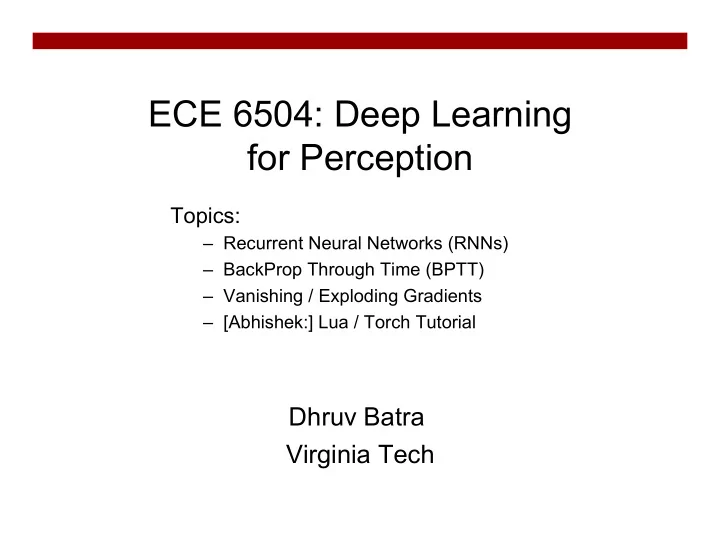

ECE 6504: Deep Learning for Perception Topics: – Recurrent Neural Networks (RNNs) – BackProp Through Time (BPTT) – Vanishing / Exploding Gradients – [Abhishek:] Lua / Torch Tutorial Dhruv Batra Virginia Tech
Administrativia • HW3 – Out today – Due in 2 weeks – Please please please please please start early – https://computing.ece.vt.edu/~f15ece6504/homework3/ (C) Dhruv Batra 2
Plan for Today • Model – Recurrent Neural Networks (RNNs) • Learning – BackProp Through Time (BPTT) – Vanishing / Exploding Gradients • [Abhishek:] Lua / Torch Tutorial (C) Dhruv Batra 3
New Topic: RNNs (C) Dhruv Batra 4 Image Credit: Andrej Karpathy
Synonyms • Recurrent Neural Networks (RNNs) • Recursive Neural Networks – General familty; think graphs instead of chains • Types: – Long Short Term Memory (LSTMs) – Gated Recurrent Units (GRUs) – Hopfield network – Elman networks – … • Algorithms – BackProp Through Time (BPTT) – BackProp Through Structure (BPTS) (C) Dhruv Batra 5
What’s wrong with MLPs? • Problem 1: Can’t model sequences – Fixed-sized Inputs & Outputs – No temporal structure • Problem 2: Pure feed-forward processing – No “memory”, no feedback (C) Dhruv Batra 6 Image Credit: Alex Graves, book
Sequences are everywhere … (C) Dhruv Batra 7 Image Credit: Alex Graves and Kevin Gimpel
Even where you might not expect a sequence … (C) Dhruv Batra 8 Image Credit: Vinyals et al.
Even where you might not expect a sequence … • Input ordering = sequence (C) Dhruv Batra 9 Image Credit: Ba et al.; Gregor et al
(C) Dhruv Batra 10 Image Credit: [Pinheiro and Collobert, ICML14]
Why model sequences? Figure Credit: Carlos Guestrin
Why model sequences? (C) Dhruv Batra 12 Image Credit: Alex Graves
Name that model Y 1 = {a, … z} Y 2 = {a, … z} Y 3 = {a, … z} Y 4 = {a, … z} Y 5 = {a, … z} X 1 = X 2 = X 3 = X 4 = X 5 = Hidden Markov Model (HMM) (C) Dhruv Batra Figure Credit: Carlos Guestrin 13
How do we model sequences? • No input (C) Dhruv Batra 14 Image Credit: Bengio, Goodfellow, Courville
How do we model sequences? • With inputs (C) Dhruv Batra 15 Image Credit: Bengio, Goodfellow, Courville
How do we model sequences? • With inputs and outputs (C) Dhruv Batra 16 Image Credit: Bengio, Goodfellow, Courville
How do we model sequences? • With Neural Nets (C) Dhruv Batra 17 Image Credit: Alex Graves
How do we model sequences? • It’s a spectrum … Input: No Input: No sequence Input: Sequence Input: Sequence sequence Output: Sequence Output: No Output: Sequence Output: No sequence sequence Example: Example: machine translation, video captioning, open- Im2Caption Example: sentence ended question answering, video question answering Example: classification, “standard” multiple-choice classification / question answering regression problems (C) Dhruv Batra 18 Image Credit: Andrej Karpathy
Things can get arbitrarily complex (C) Dhruv Batra 19 Image Credit: Herbert Jaeger
Key Ideas • Parameter Sharing + Unrolling – Keeps numbers of parameters in check – Allows arbitrary sequence lengths! • “Depth” – Measured in the usual sense of layers – Not unrolled timesteps • Learning – Is tricky even for “shallow” models due to unrolling (C) Dhruv Batra 20
Plan for Today • Model – Recurrent Neural Networks (RNNs) • Learning – BackProp Through Time (BPTT) – Vanishing / Exploding Gradients • [Abhishek:] Lua / Torch Tutorial (C) Dhruv Batra 21
BPTT • a (C) Dhruv Batra 22 Image Credit: Richard Socher
Illustration [Pascanu et al] • Intuition • Error surface of a single hidden unit RNN; High curvature walls • Solid lines: standard gradient descent trajectories • Dashed lines: gradient rescaled to fix problem (C) Dhruv Batra 23
Fix #1 • Pseudocode (C) Dhruv Batra 24 Image Credit: Richard Socher
Fix #2 • Smart Initialization and ReLus – [Socher et al 2013] – A Simple Way to Initialize Recurrent Networks of Rectified Linear Units, Le et al. 2015 (C) Dhruv Batra 25
Recommend
More recommend